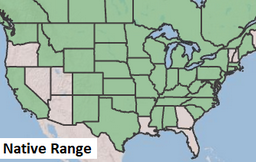Max's Sunflower
Helianthus maximiliani
Click here to download a PDF of this plant information page (for printing).

Sun Exposure: Full Sun
Season of Interest: Summer
Bloom Time: July-August
Bloom Color: Yellow
Height: 40 to 75 in.
Spread: 36 in.
Spacing: 42 in.
Water Needs: Average
Maintenance: Very little
Soil Type: Clay, Loam, Sandy
Soil pH: Neutral
Soil Drainage: Well drained
Pests: None
Diseases: Powdery mildew
Wildlife: Bees, Butterflies, Birds

Description:
Maximilian's sunflower is probably native to midcontinental prairies, but has spread along roads and railways all over North America. Maximilian's sunflower is named after Prince Alexander Philipp Maximilian zu Wied-Neuwied (1782 - 1867), who journeyed in the Great Plains and studied their natural history and anthropology. He published the two-volume "Travels in the Interior of North America" in 1839.
These sunflowers are tall perennials with long, narrow, pale green leaves. They produce large bright yellow flowers up to three inches across in a spiral around the stem. Max's sunflowers are yellow flowered perennials that provide food and shelter for a wide variety of wildlife. Butterflies and bees enjoy the nectar from the masses of late summer blooms that form a spiral around the stalk.
All sunflowers are heliotropes (sun lovers) and the flower heads turn to follow the sun as it moves across the sky. Look at the next field of sunflowers that you see. On a sunny day all of the flowers will be facing the same direction (toward the sun). In East Tennessee this plant is most often found growing in seasonally moist ditches or in open fields. For more information see:
plants.ces.ncsu.edu/plants/helianthus-maximiliani
Care and Growing Tips:
Plant the Maximilian sunflowers in a location where they can enjoy full sun, or at least six hours of direct sunlight each day. Plants that don't get enough sun may have floppy stems and may fail to bloom. They prefer well-drained soil and will even tolerate soil that is wet on occasion. While the flowers are drought tolerant and have low water needs, water regularly when you don't get rain for best growth and flowering.
These sunflowers will grow in a variety of soil types and thrive in poor soil. Fertilizer is not required. Due to their height, they are susceptible to breaking or falling over, especially in windy conditions or if the stems are weak from improper care. While not required, you can consider staking the plants or offering them another form of support.